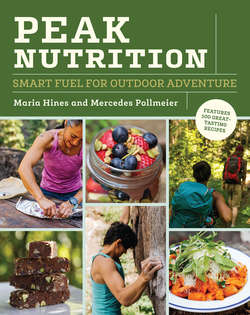Читать книгу Peak Nutrition - Maria Hines - Страница 26
На сайте Литреса книга снята с продажи.
PEAK PROFILE COLIN HALEY
ОглавлениеWHAT IS YOUR GO-TO PERFORMANCE/ENERGY FOOD AND WHY?
I end up eating a lot of packaged bars, not because they’re my preference, but because they travel well on lengthy expeditions and are convenient during hard climbs. But my favorite food for high-output days in the mountains is baguette with dried figs or, even better, onigiri (Japanese rice balls wrapped in seaweed, usually with some fish in the center).
BIGGEST CHALLENGE TO GETTING GOOD NUTRITION? ANY EASY SOLUTIONS?
At home, it’s easy to keep myself well-fed and healthy. The challenge is maintaining a healthy diet during the several months per year that I am on expeditions. When you’re packing for an expedition, it is easy to rush the food decisions, because they seem less critical than equipment decisions. There is no easy solution, but I do try to bring things like dried seaweed, powders of freeze-dried spinach and kale, dried fruit, canned sardines, etc.
WHAT IS YOUR BEST EATING HABIT? YOUR WORST?
I think my general eating habits are quite good, actually! My worst eating habit is probably that I sometimes end up doing a day or two of hard exercise with almost no food, leaving my body depleted for quite a while.
HAS YOUR APPROACH TO FOOD, IN RELATION TO PERFORMANCE, CHANGED OVER TIME?
For some time I was a bit “tricked” by food fashions that dictate a certain ratio of macronutrients, like the keto or paleo diets. Even though I never really followed any of them, I definitely made conscious decisions to eat more protein and fat than I naturally craved. More recently I reverted to eating whatever ratio of macronutrients I grew up eating and naturally crave, which I estimate to be about 65 percent carbohydrates, 25 percent fat, and 10 percent protein (by calories). I feel healthier than when I was intentionally trying to eat more meat.
WHAT IS YOUR FAVORITE FOOD INDULGENCE AT THE END OF THE DAY?
Mochi with bean-paste filling! Also, I always think coconut water is tremendously delicious.
LIGHTNING ROUND: DOGS OR CATS? VAN, SUV, OR TRUCK? DOWN OR FLEECE?
I like dogs, but I love cats. I no longer own a vehicle at all, which is a dream come true, but if I were to ever buy one again it would be either a tiny little “commuter” car or a van I can sleep in comfortably. I’ll try to wait for an all-electric, self-driving van!
Colin Haley is a professional alpinist. Originally from Seattle, he currently makes his home base in Chamonix, France, where he prepares himself for expeditions to extreme mountains.
THE FIVE WHYS
To go deeper, try an exercise called the Five Whys, originally developed by Sakichi Toyoda and used to help make decisions at the Toyota Motor Corporation. First, ask what it is you want to accomplish, then ask why to the answer, then ask why to that answer, and so on—five times. Check it out:
•What do you want to accomplish? I want to lose fat.
•Why do you want to lose fat? Because I want to feel lighter when I climb.
•Why do you want to feel lighter when you climb? Because when I’m lighter, it’s easier to climb harder.
•Why do you want to climb harder? Because when I’m climbing harder, more people will like me.
•Why do you want more people to like you? Because when more people like me, I feel more confident.
•Why do you want to be more confident? Because when I’m more confident, I feel freer to be myself.
Wow, there’s a lot here. So much can come from asking a few simple questions. Doing a few rounds might help you get to the core of your beliefs and values and what’s really important to you. There is no right or wrong. Once you have gone through this process, start creating goals that are in line with your intrinsic values and identity. Intrinsic goals are easier to accomplish than externally validated goals. Revisit the Five Whys at another time with the same question, and you may end up with different answers.
What are your values? Think about your identity. Take a few minutes to jot down as many values as you can that create your identity. Then do a few rounds of the Five Whys.
Then map out your superpowers—traits that will help you reach your goals. For example, “I am an athlete” = superpower: I am driven. Or “I am a student” = superpower: I am coachable. For each identity, come up with a superpower. Also figure out the flip side, the trait of each identity that might hold you back. For example, “I am an athlete” = flip side: I am competitive with myself and others. Or “I am a student” = flip side: I am scatterbrained, on information overload. This last flip side would mean that you need to be careful with goals that are number driven, and you also have to focus on one thing at a time to avoid melting your brain.
What is your identity? What are your superpowers?
“You’ve gotta know yourself to grow yourself.” —Stephen S. Hall
You have now figured out what your identity is and what your superpowers are to help you deal with failure, and you have planned for failure and scheduled your super-simple habits into your day. This is looking more like a process or a system than a plan, which is great, because it is more flexible and dynamic than a plan, just like life itself.
